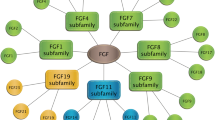Abstract
Fibroblast growth factor (FGF) receptors constitute a family of four membrane-spanning tyrosine kinases (FGFR1–4) which serve as high-affinity receptors for 17 growth factors (FGF1–17). To study functions of FGF/ FGFR signals in development, mice that carry mutations in each receptor have been created by gene targeting. Analysis of these mutant mice revealed essential functions of FGF receptors in multiple biological processes, including mesoderm induction and patterning, cell growth and migration, organ formation and bone growth. In this review we discuss recent work with FGF receptors to illustrate mechanisms, through which the FGF/FGFR signals specify vertebrate limb initiation, outgrowth and patterning.
Similar content being viewed by others
Author information
Authors and Affiliations
Additional information
Received: 31 August 1998 / Accepted: 21 December 1998
Rights and permissions
About this article
Cite this article
Xu, X., Weinstein, M., Li, C. et al. Fibroblast growth factor receptors (FGFRs) and their roles in limb development. Cell Tissue Res 296, 33–43 (1999). https://doi.org/10.1007/s004410051264
Issue Date:
DOI: https://doi.org/10.1007/s004410051264




